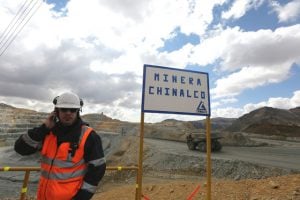Venezuela is a country on the brink of collapse. Its reserves of crude oil, the largest in the world, underwrote some US$65 billion (440 billion yuna) in debt to China issued since the turn of the millennium. But with the recent crash in international oil prices came fears over how the debt would be repaid as the country sank into profound economic and political crises.
The China-Venezuela partnership is often cited as a prime example of the former’s early approach to Latin America. This largely involved providing loans to commodity-exporting countries in order to guarantee supplies of products such as soya, copper, iron ore and oil, which are central to China’s development. But many believe this partnership has exacerbated the environmental problems associated with the continent's booming mining and agriculture industries.
But China is not a monolithic actor synonymous with the party-state and engagement has taken place in a variety of ways, as Margaret Myers and Carol Wise point out in their new book The Political Economy of China-Latin America Relations in the New Millennium.
Myers, who is director of the China-Latin America programme at the think tank Inter-American Dialogue speaks about her new book, the shifting political currents in Latin America, and how Chinese investors, along with new partners like Colombia, are learning from past successes and failures.
Robert Soutar [RS]:The book looks at political and economic relations between China and Latin America since the turn of millennium, how have these changed in that time and why is now an important time to publish this book?
Margaret Myers [MM]: I don't think we've seen major changes on the economic side, in the trade or investment relationship or even, frankly, in the finance to Latin America. But certainly there has been some political reaction to China's growing economic influence in the region. What I largely see is more sensitivity on the part of Chinese policymakers and scholars to many of the domestic political currents in Latin America.
We're seeing a fall in commodities prices, a "new normal" in China, really slow growth in many countries in Latin America and some fascinating political shifts in place like Argentina, Cuba and Peru that have surprised China in certain cases. At this point there's an effort on the part of companies and the government itself to determine how best to approach the region and individual countries in the next months and years.
RS: During the “China boom” mostly presided over by left-leaning governments, there was a tendency to brush off environmental concerns in growth sectors like mining and agriculture. With the return to a more orthodox market economics in places like Argentina, Brazil and Peru, how worrying is it that environmental legislation will be further rolled back?
MM: It's a little early to say in the cases of these new governments. There's been talk in Peru of changing mining regulations to permit more mining investment. Corruption and disregard for environmental regulations seem to still be in full force in Venezuela, which, as we know, is deteriorating very rapidly. In Brazil there's a lot of talk about reforming, yet again, the land law that was changed in 2010 to allow more foreign investment in Brazilian land. Depending on how that's handled that could be a challenging thing for Brazil from an environmental perspective. Chinese companies are finding it increasingly difficult to approach the region and especially those countries that have very recently experienced political shifts.
RS: China’s more recent Latin America strategy appears to be to build relationships beyond countries considered “high-risk”, like Venezuela, to include more open countries like Colombia. What will these countries have learned from the experience of their neighbours and what will they do differently?
MM: Because of their investment environments, Colombia and to a certain extent Chile and Peru are actually inclined to engage China very differently. These countries have for many years had access to a wide variety of international creditors and haven't needed China in the way the Venezuelans and Ecuadoreans have. If anything, I think Chinese companies have had a bit of a disadvantage because of perceptions of Chinese companies in Colombia.
But one of the great examples of really positive investment was that of [truck manufacturer] Foton which is advancing this goal of “production capacity development” [investing in infrastructure and industries with greater value-added, such as manufacturing, in order to achieve growth] as the Chinese like to call it. Colombia has certainly seen disastrous cases in Venezuela and neighbouring countries. But if anything that confirms their approach, which is slow and steady, and treating Chinese companies just as they would any other international investor.
RS: Peru passed a prior consultation law in 2011 for projects that affect local communities yet conflicts persist. What can host governments do in partnership with Chinese companies to avoid such conflicts?
MM: There's an organic learning process on the part of Chinese companies. They've entered the region not fully understanding a lot of the challenges that companies have previously faced in these sectors and adapted their strategies to try to deal with those. Chinese companies need more information on companies active in specific countries. So far, Chinese companies have been reluctant to purchase information. A wide variety of Asian companies are investing in information services in order to be well-engaged when they deal with the region and do risk analysis.
RS: You write about the explosive growth in soya exports to China from Argentina and Brazil; and big, Chinese, state-run grain corporations like COFCO acquiring multinational grain dealers. What will happen to the purchased company’s sustainability policies as a result?
MM: I tend to think it's a more positive outcome. Because the idea in engaging in mergers and acquisitions (M&A’s) across the board is to effectively have a presence in Latin America where it would otherwise be impossible to do so. It's the only point of entry that China is able to identify at this point given all the competition they face from international companies. But also you're acquiring a reputation, you're acquiring staff that has considerable experience and knowhow in terms of operations. It's not just for profit. Looking at [Shuanghui's acquisition of US pork producer] Smithfield. There was a lot of concern that Smithfield's relatively responsible production standards would decline rapidly on the Chinese purchase of the company and that just hasn't been the case.
RS: One thing that doesn’t get much mention in the book is China’s engagement with Latin America through new multilateral institutions like the BRICS bank and AIIB, which may start funding infrastructure in the region. How does this differ to China’s unilateral approach?
MM: There are very small staffs in both institutions and things are only just getting going. It's unclear how the BRICS will lend and to what extent they'll lend to Latin America aside from Brazil. The AIIB is supposed to be a compromise with regard to the standards and safeguards that exist within current multilateral lending organisations or previous Bretton Woods-type institutions and what China has done in international finance, although it tends to be leaning towards the more traditional model.
RS: What do you see as the main challenges in the next 10 years and how can they be overcome?
Many of the challenges that will exist in the coming years are ones that will have existed already for over a decade. It's an old point but we make it again in the book – the need to diversify trade and investment between China and Latin America.
Another challenge for China is image. One would think China's image would have improved considerably by now given over two decades of heightened engagement with almost every country in the region but that's not necessarily the case. In some ways China's partnership with Venezuela has potentially damaged its image as China is seen as having propped up the Chavista administration.
The original version of this article was published here on Diagolo Chino.






